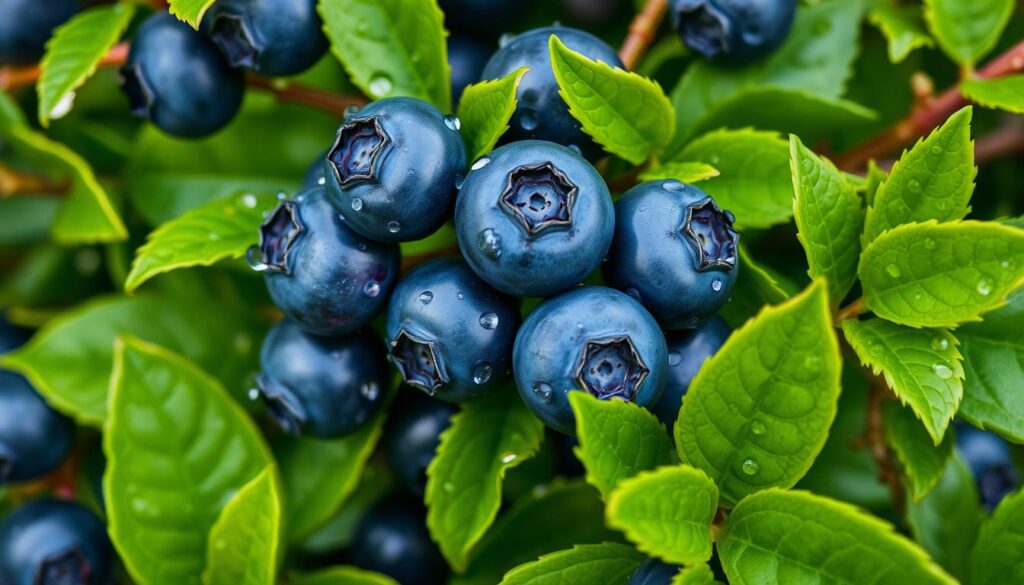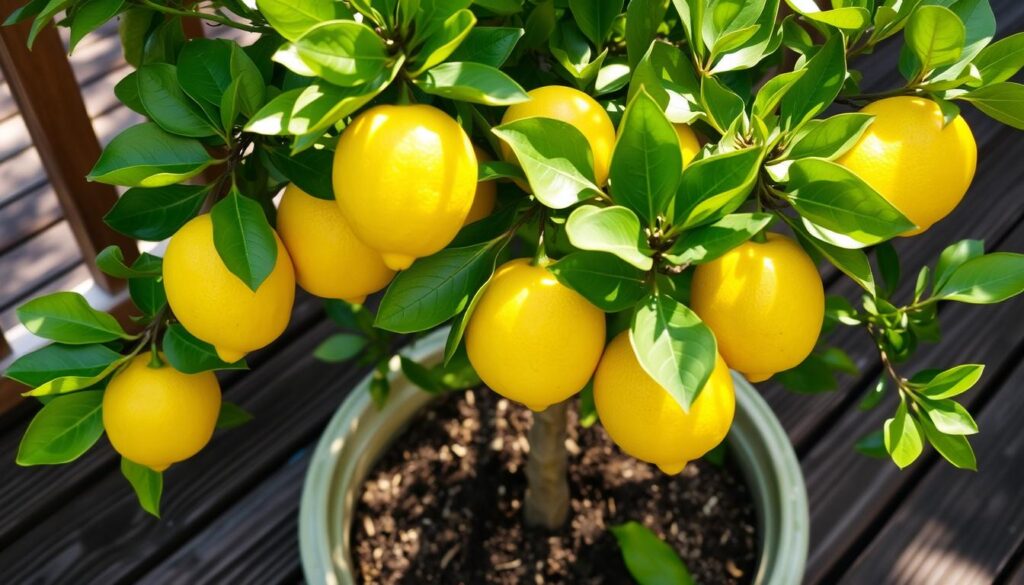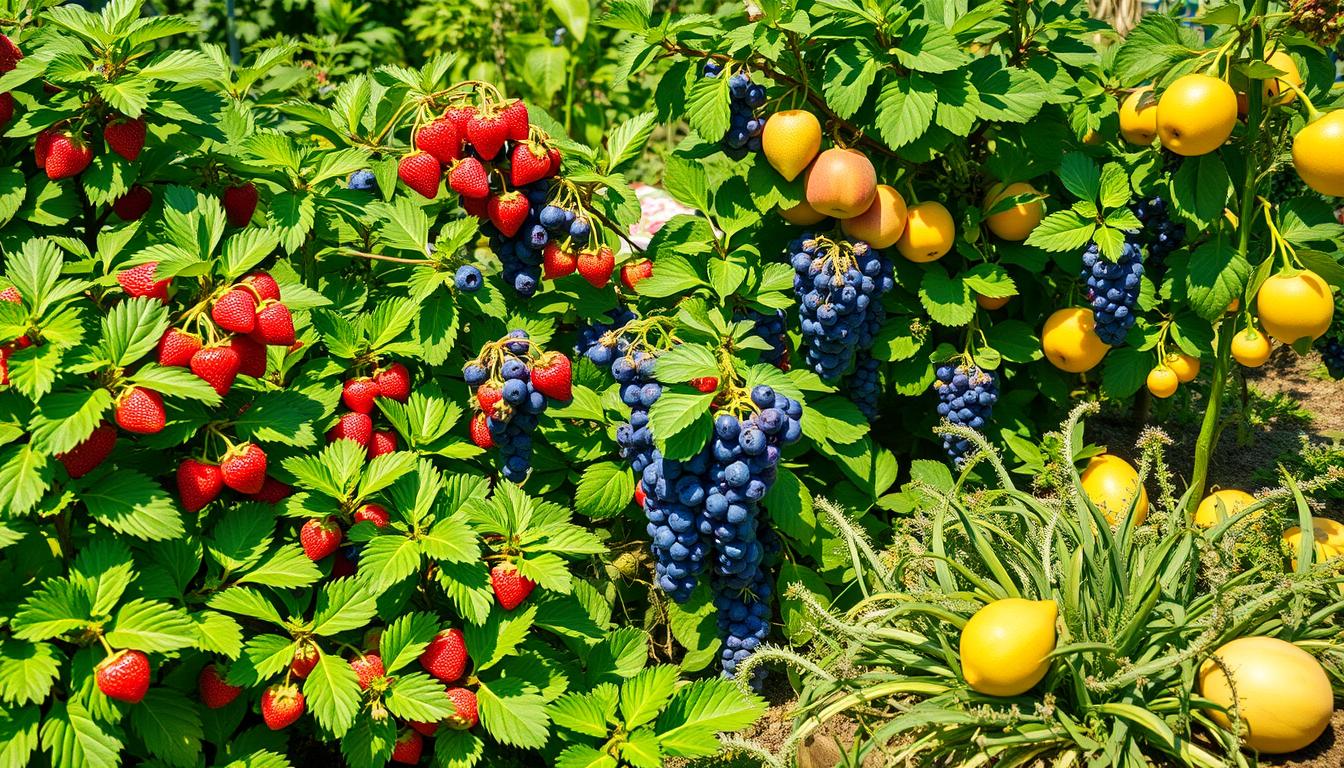As a passionate gardener, I know the joy of growing fresh food at home. If you want to get the most from your garden fast, focus on the Top 10 Fast-Growing Fruits. These fruits grow well in different conditions and taste amazing, all in a short time.
In this article, I’ll share how to grow each fruit best. From blueberries to peaches, these trees can turn your garden into a fruitful paradise. My tips are for everyone, whether you’re new to gardening or have lots of experience. You’ll soon enjoy the fruits of your labor!
Key Takeaways
- Blueberries yield fruit within 2 to 4 months after flowering.
- Peach trees can produce ripe fruit in as little as 1 to 2 years.
- Raspberry bushes thrive in long, cold winters and provide fruit from midsummer through fall.
- Strawberries can be harvested the year after planting for high yields.
- Lemon trees, like Meyer lemons, grow quickly and flourish in containers.
- Mulberry trees adapt well to various conditions and produce fruit rapidly.
Introduction to Fast-Growing Fruits
Fast-growing fruits are perfect for gardeners who want quick results. They are great for those with little time or space. I look for fruits that grow fast, so I can enjoy them early.
When I started growing fruit indoors, I chose mango and peach trees. They bear fruit quickly, often in the same year. Tropical fruits like guava and mulberry also grow fast, usually in one to two years. Knowing what each fruit needs helps me grow them well, indoors or outdoors.
To find the best fast-growing fruits, I learn about their care. The right care boosts harvests and fruit life. Seeing fruits grow early makes gardening even more fun.
The Benefits of Growing Fast-Growing Fruits
Growing fast-growing fruits brings many benefits to gardening. One big plus is the quick harvest, which gives me instant joy. This is great for beginners who want to enjoy gardening right away.
These fruits, like blueberries and raspberries, do well in small spaces. They’re perfect for city gardens or tiny backyards. This means I can grow delicious fruits even in tight spots.
These fruits are also packed with vitamins and antioxidants. For example, the Fignomenal Fig tree not only gives me lots of figs. It also attracts helpful pollinators, making my garden better for all living things.
Proper fruit tree care is key for healthy plants. Fast-growing fruits need less care, so I have more time to enjoy them. With the right tips, I can have a beautiful garden filled with nature’s wonders.
| Fruit Type | Growth Time | Health Benefits | Pollinator Attraction |
|---|---|---|---|
| Blueberries | 1-2 Years | High in vitamins, antioxidants | Yes |
| Raspberries | 1-2 Years | Rich in vitamins, fiber | Yes |
| Strawberries | 5-6 Weeks | Packed with Vitamin C | Yes |
| Fignomenal Fig | 1-2 Years | Excellent source of fiber | Yes |
| Donut Peach | 2-3 Years | Rich in vitamins A and C | Yes |
Blueberries: A Quick Harvest in Your Garden
Blueberries are a great choice for quick fruit growth. They love acidic soil and lots of sunlight. Blueberry bushes can grow big, so make sure to space them right.
Plant them at least six feet apart for best results. This helps with air and light, leading to more berries.
Growing Conditions for Blueberries
Getting the right conditions is key for growing blueberries. They need moist, well-drained soil. Water them well, especially in the first years.
Soil sulfur can help keep the soil acidic. Mulch and companion plants help too. They keep the roots warm and attract pollinators.
Harvesting and Maintenance Tips for Blueberries
Blueberries ripen in early June, making it a fun time in the garden. Watch for them to turn blue before picking. After picking, keep the soil moist and prune lightly in spring.
Protect your berries from birds. For a tasty treat, try Jody’s Best Blueberry Cobbler. It’s easy to make with blueberries, sugar, and Bisquick.
There are many blueberry types for different climates. ‘Blue Crop’ does well in cooler areas, while ‘Rabbit-eye’ prefers the south. Find the right one for your garden. For more tips, check out this resource on growing blueberries.

Peach Trees: Quick to Produce Delicious Fruits
Peach trees are some of the fastest-growing fruit trees. They can start producing fruits in two to three years. This makes them a great choice for any garden. It’s important to pick the right variety for your area to ensure they grow well.
With the right care, these trees can give you sweet, juicy peaches. They also add beauty to your garden.
Choosing the Right Peach Tree Varieties
For container gardens, choose dwarf peach trees. For bigger spaces, go for standard varieties. Some peach trees don’t need cross-pollination, making them easier to care for.
Grafted peach trees often give better yields and quality fruits. Make sure to plant them with enough space for good airflow. This helps prevent diseases and promotes healthy growth.
Care and Pruning Techniques for Peaches
Proper care is key for peach trees to thrive. Prune them in winter or early spring to improve fruit production. Peach trees can grow up to two feet a year.
Pruning helps control their height, which varies by variety. Mulching is also helpful. It keeps the soil moist and controls weeds, giving your trees a healthy environment.
Raspberries: Easy and Abundant Crops
Growing raspberries is a rewarding venture for any gardener. These delightful berries belong to the genus Rubus spp. They are known for their ability to produce an impressive yield with minimal effort. I appreciate the flexibility of raspberry plants, as they can be categorized into summer and fall-bearing varieties.
This means I can plan my planting schedule for a longer harvest season. Raspberries thrive in well-drained, organic-rich soil. They are hardy enough to withstand subzero winters, making them ideal for growing in Zones 3 to 9.
When I plant my raspberries, I ensure to space the canes 20 inches apart with rows set 5 feet apart. This careful spacing helps manage their vigorous spread. It encourages ease of maintenance and harvesting. While raspberries tolerate partial shade, they yield significantly more fruit in full sun with at least 6 hours of direct sunlight a day.
For those interested in home gardening, there are multiple raspberry varieties to choose from. Popular ones include ‘Latham’, ‘Encore’, and ‘Killarney’ for summer-bearing types. ‘Autumn Bliss’, ‘Caroline’, and ‘Heritage’ are good for fall-bearing options. I recommend planting a mix of varieties to enjoy a continuity of fresh raspberries throughout the season.
It’s important to remember that these plants are self-fertile but can produce better yields when pollinators are nearby.
Maintaining raspberry plants involves some basic care practices. Pruning is essential and differs between summer and fall-bearing varieties. I find that regular pruning not only helps control overgrowth but also promotes healthier and disease-free plants.
Once the berries are ripe, it’s time to harvest. Look for deep-colored fruits that release easily from the stem, indicating perfect ripeness. This method ensures that I enjoy the best quality raspberries from my backyard fruit trees.
| Raspberry Variety | Type | Harvesting Time |
|---|---|---|
| ‘Latham’ | Summer-bearing | Late June to early August |
| ‘Autumn Bliss’ | Fall-bearing | Mid-July to end of September |
| ‘Royalty’ | Purple | Summer |
| ‘Anne’ | Yellow (fall-bearing) | Mid-July to end of September |
For optimal results, I ensure that my raspberry canes are planted in spring. I provide them with a trellis system for support, especially with trailing varieties. Fertilizing in early spring with a balanced fertilizer can enhance growth and production.
With proper care and attention, my raspberry plants continue to produce delicious fruit for a decade or more. They are an invaluable addition to my collection of backyard fruit trees.
Apple Trees: Fast-Growing Options for Your Space
Apple trees are great for growing because they grow fast and are easy to care for. They start producing fruit in just three to five years. This makes them perfect for gardeners who want to see results quickly.
Dwarf apple trees are especially good for small spaces. They can grow in tiny gardens or even in containers. This makes them ideal for people with little room to garden.
Taking Care of Dwarf Apple Trees
Dwarf apple trees need well-drained soil and lots of sunlight, about 6-8 hours a day. They grow to be 10 to 15 feet tall, which is easy to manage in cities. To get the most fruit, it’s important to prune them regularly and keep pests away.
It’s also key to plant them far enough apart. Many apple trees need another tree nearby to pollinate properly.
Understanding Different Apple Tree Varieties
There are over 8,000 apple tree varieties out there. Choosing the right one can be hard. Some trees need a partner to pollinate well.
Apple trees grow well in zones 3-9. I suggest pairing a tree that can’t pollinate with one that can. This way, you get the best fruit.
One great choice is the disease-resistant columnar apple tree. It grows up to 10 feet tall but only 2 feet wide. This makes it perfect for small gardens.
If you want to grow apple trees, do some research first. This will help you get the most fruit and have a successful gardening experience.
Passion Fruit Vines: A Tropical Delight in Your Garden
Growing passion fruit vines brings exotic beauty to my garden. They are among the most sought-after tropical fruits. Passiflora edulis, a common choice, has over 50 varieties with unique flavors and colors.
These vines love full sun and well-drained soil with a pH of 5.5 to 6.5. They can grow up to 15 feet tall and spread three to five feet wide.
Planting seeds, fresh ones germinate in 10-20 days. Older seeds take longer. The vines can grow 20 feet in a year. They bloom in early spring and fruits are ready in about 80 days.
For best results, water them consistently. Use a 10-5-20 NPK fertilizer to support their growth. Keeping the soil moist is key as the roots need space to grow.
These plants usually live five to seven years. To keep a steady supply, plan for succession. With care, you can enjoy the sweet flavors of purple and yellow passion fruits.
Strawberries: Quick Yields and Flavorful Berries
Strawberries are easy to grow and perfect for home gardeners. They offer a quick harvest and add color and taste to the garden. To grow strawberries, you need to pay attention to a few details.
How to Establish a Strawberry Bed
Choosing the right strawberry variety is key. Seascape and Earliglow are great choices. Here’s how I set up a strawberry bed:
- Find a spot that gets full sun for at least six hours a day.
- Make sure the soil drains well and add organic matter to make it fertile.
- Plant them far enough apart to avoid overcrowding and to keep air moving.
- Keep the soil moist but not too wet, as strawberries like it that way.
- In the first year, remove flowers to help the plants grow strong roots.
Harvesting Strawberries for Maximum Yield
Harvesting strawberries is exciting. Here’s how to get the most from your crop:
- Pick ripe strawberries by twisting the stem gently. This ensures you get the best flavor.
- Check often for pests and diseases to protect your strawberries.
- Use mulch to keep the soil moist and control weeds.
- Fertilize as needed to help the plants grow and produce more fruit.
- Try different varieties to keep getting strawberries throughout the season.
With the right care, strawberries can give up to 3 pounds of fruit each season. They’re a tasty and rewarding addition to any garden. For more tips on gardening, check out this contact page that offers great advice.
| Strawberry Variety | Key Features | Zones |
|---|---|---|
| Seascape | Heat-tolerant, large berries, continuous production | 4-9 |
| Earliglow | Large, juicy, disease-resistant | 4-8 |
| Sweet Kiss | High yields, day-neutral | 4-8 |
| Alpine Alexandria | Small berries, produces throughout summer | 5-9 |
Lemons: Fragrant and Fast-Growing Citrus
Lemon trees are a stunning addition to any garden. They offer fragrant blooms and fruit quickly. The *Meyer* lemon is my favorite for container gardening, perfect for small spaces like patios or balconies. Other favorites include the *Eureka* and *Genoa* lemons, each with its own flavor.
These fast-growing citrus trees love warm climates and lots of sunlight. Regular pruning is key to keep them healthy and productive. They also have beautiful white flowers and shiny leaves all year.
I feed my lemon trees with citrus-specific fertilizers all year. From late March to October, I use a high-nitrogen fertilizer. Then, I switch to a balanced feed in the colder months.
Humidity is crucial for lemon trees, especially in winter. More moisture helps with pollination, which is important since they mostly pollinate themselves. For those growing lemons in pots, remember to water right during the growing season but avoid overwatering.

| Variety | Best for | Growth Rate | Container Size |
|---|---|---|---|
| Meyer Lemon | Small Spaces | Fast | 5-10 Gallons |
| Eureka Lemon | Home Gardens | Moderate | 10-15 Gallons |
| Genoa Lemon | Yards or Patios | Moderate | 10-15 Gallons |
Growing lemons is very rewarding, even in small spaces. With proper care, they offer delicious fruit, fresh flavors, and beautiful blooms all year. Nurturing my lemon trees brings a wonderful scent and taste to my kitchen.
Mulberries: A Thriving Tree for Fast Fruit
Mulberries are a standout choice for gardens. They are hardy, adaptable, and produce sweet, nutritious fruit. These fast-growing trees do well in many places, from city backyards to rural areas.
Growing Mulberries in Different Climates
Mulberries grow well in many conditions. They like loamy soil and full sun but can handle partial shade. With 68 species, most come from Asia, especially China.
- White Mulberry (Morus alba): This grows fast, up to 20 meters tall. It’s good for zones 4b to 9a and can handle cold.
- Red Mulberry (Morus rubra): It’s best for warm, temperate areas. It gives tasty fruit and helps local wildlife.
- Black Mulberry (Morus nigra): Known for its rich taste, it’s best in milder climates.
Mulberries are self-fertile, so you only need one tree for fruit. Pruning them every year helps them grow well. Grafting or cloning means they can start producing fruit right away. With the right care, they can really improve your garden’s look.
Conclusion
Adding fast-growing fruits to my garden brings a tasty harvest and makes my outdoor area look great. I focus on easy fruits like blueberries, peaches, and strawberries. This way, I get to enjoy the fruits and the beauty of the plants.
Knowing how to care for each fruit tree is key. It helps me get a good harvest every year. This knowledge makes my gardening efforts worthwhile.
When I grow different fruits, I see quick results. Raspberries, for example, can grow fruit in just one year. Fig and kiwi trees also produce fruit in a couple of years.
By taking care of the soil, watering, and temperature, I help my plants grow well. This makes my garden a success.
Enjoying the fruits of my labor is rewarding. It’s not just about the taste but also the joy of growing them. As I try new things and share what I learn, I get better at gardening. My garden becomes a lively and fruitful oasis.



Leave a Reply